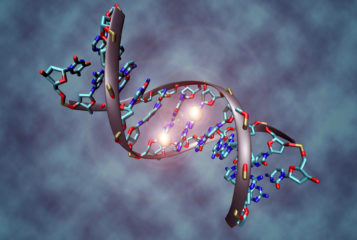In recent years, significant progress has been made in identifying some of the genetic factors that underlie common complex diseases such as diabetes, obesity, hypertension and cancer. This has been possible due to the genome-wide association study (GWAS) approach that involves comparing genetic variants in large numbers of individuals that have the disease versus those that do not. In the last five years, approximately 600 GWASs have examined over 100 human diseases, uncovering more than 800 genetic variants associated with one or more diseases. However, in nearly every case, the majority of factors that cause the disease are still unknown. This has led to an interest in exploring non-genetic factors that could impact on disease etiology.
Epigenetics is the study of processes that regulate the expression of genes but, crucially, do not change the DNA sequence. Examples of epigenetic modifications include the addition of chemical groups (for example methyl groups) to the DNA - DNA methylation. During normal development, the cell tightly regulates DNA methylation. However, both environmental (such as diet and smoking) and stochastic factors can alter these DNA methylation profiles, resulting in aberrant DNA methylation marks, meaning some genes are turned on or off in an aberrant manner. The association between aberrant DNA methylation and cancer has been known for nearly 25 years, but the link with common non-malignant diseases (such as diabetes) is only just beginning to be explored.
Based on the experience from GWASs, it is inevitable that we will have to perform large-scale, systematic studies of epigenetic marks in a large number of individuals to properly understand the role of epigenetics in disease etiology, for example using epigenome-wide association studies (EWAS). But how do you conduct an EWAS? Compared with a GWAS, an EWAS represents a more challenging proposition, and below is a description of the key distinctions between GWAS and EWASs.
Firstly, unlike the genetic sequence, epigenetic marks can vary between tissues. Although almost any tissue can be used in a GWAS, the choice of tissue in an EWAS is therefore an important consideration. Typically, you sample only a few tissue types from a large number of live individuals: blood, hair, skin, buccal cells, and in some cases also muscle and fat biopsies. Consequently for diseases such as autoimmune disorders, a blood-based component, it should be possible to perform an EWAS. However, brain-based conditions may be harder to study in an EWAS, although in some diseases the aberrant epigenetic mark may be present in many/all tissues.
Secondly, another distinction between GWAS and EWAS is which epigenetic mark to profile, as several different types of epigenetic marks exist. To profile large numbers of individuals, the mark must be stable and amenable to high-throughput analysis, and currently DNA methylation is the most suitable mark for EWAS.
Thirdly, in a GWAS any disease-associated genetic variant found has to be causal for the disease, in other words the disease itself does not cause the genetic variation. However, given that epigenetic marks are responsive to the environment, in some cases altered physiology in the diseased individual may cause epigenetic perturbations. Therefore, what you end up studying is not a mark that predisposes to the disease, but rather a mark caused by the disease, which may have little to do with the disease aetiology. Therefore this may not be a very good target candidate for either therapeutic or predictive purposes.
In a typical GWAS, you normally compare thousands of overt disease-affected individuals with unrelated unaffected controls. This design, if used in the context of an EWAS, would not be able to distinguish whether epigenetic differences identified between the two groups occurred before or after the disease. Or whether any of the epigenetic differences were due to genetic differences between the two populations. For an effective EWAS, it is much better to perform longitudinal studies that follow initially disease-free individuals from birth. However, such studies are expensive and time-consuming, but do offer a method for distinguishing epigenetic variants that are causal for, or consequential to, the disease process. Monozygotic twins, genetically identical individuals brought up in very similar environments, are also valuable for EWASs, as they allow you to exclude genetic differences as the cause of the disease-associated epigenetic marks.
Despite the challenges of conducting an EWAS, such studies are already underway and there is reason to be optimistic that they will yield new insights into the causes of common diseases. The ultimate aim of EWAS, like GWAS, is to provide a better understanding of disease aetiology, and it is likely that no single approach will be able to completely define disease aetiology. However, the combination of GWAS and EWAS approaches, and other methods such as computational biology and functional studies of identified genetic or epigenetic variants, should lead to a better understanding of the disease process and the potential development of novel therapeutics and diagnostics in the future.





Leave a Reply
You must be logged in to post a comment.